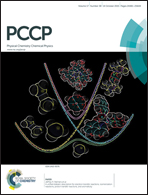Low polarity water, a novel transition species at the polyethylene–water interface†
Abstract
The bridge between water repelling and water-attracting regions is recognized here as low polarity water, a novel “neutral” form of water; its identity as a dipole–dipole water dimer is supported by spectroscopic evidence of its presence in thin films of water on a polyethylene surface. High resolution (0.5 cm−1), low signal energies (Sg 100) and short scans (0.1 s) are used to ensure that all peaks are detected. Thin films may be trapped between two polyethylene windows, affirming the low polarity of such water; the spectra of the trapped films (“sandwich”) are similar to those from a subtraction procedure. Use of the “sandwich” is a new and useful technique in surface studies. In general, intermediate forms might bridge incompatibility between different regimes, from sets of molecules (chemistry and physics) to sets of organisms (biology and sociology). Thin films of water on polyethylene also display strong and transient peaks of water oligomers, cyclic pentamers and cyclic hexamers (chair and boat), bicyclic hexamers (books 1 and 2) and tricyclic hexamers (prism) that have been previously identified in thin films of water on a silver halide surface.


 Please wait while we load your content...
Please wait while we load your content...